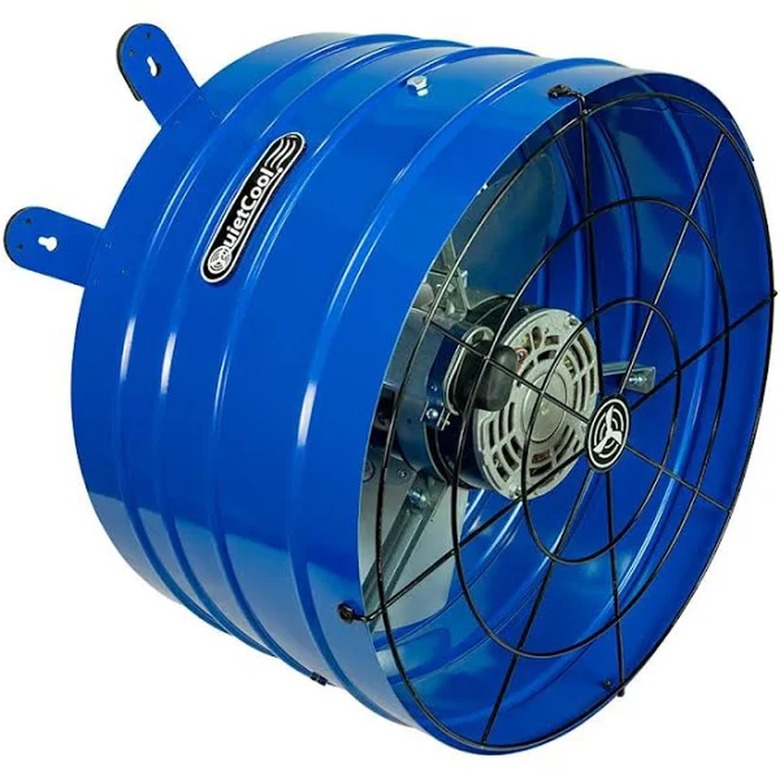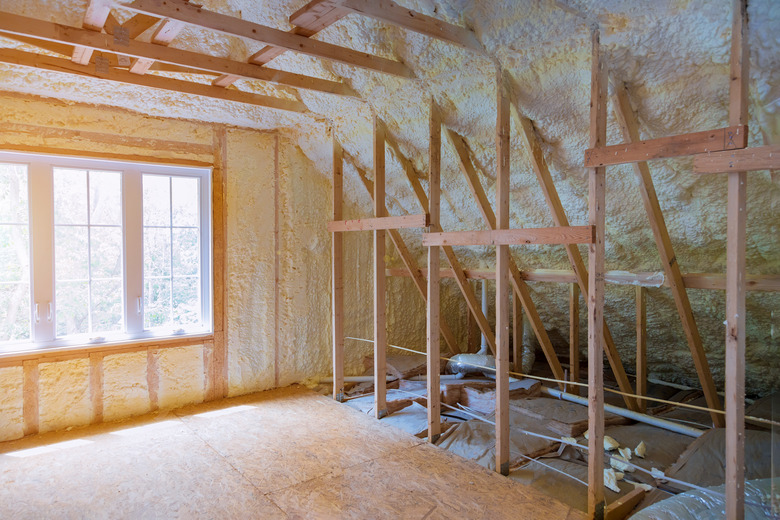Are Attic Fans Necessary Or Even A Good Idea?
We may receive a commission on purchases made from links.
If you've ever climbed the stairs to your attic in the middle of summer, you know the feeling you have as you step into the attic from your air-conditioned home below. The temperature differential between your cool living spaces and your hot attic space above is significant, with attic temperatures potentially exceeding 150 degrees Fahrenheit in this unconditioned space. Often touted as the remedy to keep your attic cooler, attic fans (not whole-house fans) can actually accomplish this goal but at an overall detrimental consequence.
Not to be confused with whole-house fans, which are ceiling-mounted fans that pull air in through open windows and push it into the attic to cool a home, attic exhaust fans are designed to cool the attic instead of the living space below. Although the precisely correct term is "power attic ventilator" (PAV), "attic fan" is the common name that's recognized by homeowners as well as the HVAC industry to distinguish this device from a whole-house fan. Terminology aside, when you get to the science behind what makes an attic fan work, you may be surprised to find that installing an attic fan may not be a good idea for your home.
Tip
The value of an attic fan is marginal at best and even potentially dangerous.
Heat Buildup in Attics
Heat Buildup in Attics
The inordinate amount of heat in attic spaces (compared to conditioned air in living spaces) starts with the sun, of course, but your home's roof plays a role in intensifying this heat. Roofing materials, particularly dark-colored asphalt shingles, absorb heat and conduct it downward to the roof deck. Then, it's the roof deck that radiates this heat into your attic, where the objects and structures inside absorb the heat. If your roof is tilted directly toward the sun, it captures and conducts even more heat. Everything inside your attic is fair game for heating up, including the rafters, insulation, ductwork and stored items.
When your stored items include things like your family's heirloom holiday decorations, you may be compelled to install an attic fan to mitigate the damage they may sustain from intense attic heat. Even if you don't store many items in your attic, you may want to install an attic fan to save money on your cooling bills. However, when you compare the perceived benefit of an attic fan to its downsides, you may choose another option for keeping your attic cooler.
How Attic Fans Work
How Attic Fans Work
Attic fans pull in cooler air from outside your home's building envelope — its external structure and insulation layer, including the walls and roof — while pushing the hot air inside the attic to the outside. Your home's soffit vents, gable vents and ridge vents are key players in attic-fan functionality because these roof vents enable the air transfer. Depending on the size of a house, homeowners may have only one attic fan or multiple fans.
Attic fans should facilitate 10 air changes each hour. By multiplying an attic's total square footage by a factor of 0.7, you can calculate the necessary cubic feet per minute (CFM) rate required for an attic fan. For example, if your attic is 1,000 square feet, you'll need an attic fan that's rated 700 CFM (1,000 square feet multiplied by 0.7). If your roof is dark or steep, you should add 15 percent to that figure, resulting in 805 CFM.
The Science Behind Attic Fans
The Science Behind Attic Fans
In theory, attic fans seem to be the perfect solution for lowering the oppressive heat buildup in attics, but the science behind this theory proves otherwise. When an attic fan pushes air out of an attic, it doesn't just move air from the attic; it can also suck air from conditioned living spaces and expel it from your home.
This means some of your cooled indoor air gets pulled into the attic, where the attic fan pushes it out, forcing your air conditioner to work harder, which increases your utility bill. You'll not only be paying for the attic fan and the power to run it but you'll also pay more on your utility bills for the additional energy required to overwork your AC.
An exception to this loss of conditioned air from your living space into the attic applies only to homes with ceilings that are completely sealed from the attic. However, even with a sealed ceiling, your money may be better spent on improving insulation levels and natural attic ventilation rather than paying for the energy to run an attic fan.
Other Downsides of Attic Fans
Other Downsides of Attic Fans
In addition to the inefficient use of energy required to operate an attic fan plus its installation costs, there are other downsides. Even if you have a sealed ceiling, cool air can still escape from your living areas through the attic door. If your roof venting system is inadequate or if one or more vents is even partially blocked, the attic fan must work harder.
Other than pulling conditioned air from your living spaces, attic fans can also reach beyond these areas and pull air from your basement or crawl space. The moist conditions that exist in many basements and crawl spaces can be a breeding ground for mold. If your attic fan is pulling this moldy air from your basement or crawl space through your home before it reaches your attic and eventually exits your home, then you and your family will be breathing in mold spores.
Safety Issues With Attic Fans
Safety Issues With Attic Fans
Inhaling mold spores that your attic fan may pull from the damp recesses of your basement or crawl space is only one potential health and safety hazard associated with these fans.
If your furnace is installed in your attic, an attic fan may blow out the pilot light because of the draft it produces (if you have an old furnace with a standing pilot light). When the pilot light is extinguished, the furnace may expel gas into the attic. Although the attic fan will expel much of this gas with the hot air it pushes out, the fan does not run continuously. When the fan is not running, gas can collect in the attic and potentially infiltrate your home through cracks in the ceiling and around the attic door.
If you have a chimney with a damaged flue, an attic fan can pull carbon monoxide from the flue into the attic and then into your living spaces below. Another carbon monoxide danger is called "backdraft," which can also occur in a home with an attic fan. Essentially, this happens when an attic fan pushes carbon monoxide from gas appliances, such as water heaters, into your home. It's a good idea to install a carbon monoxide alarm in your home if you have a chimney or gas appliances as well as an attic fan to keep on top of this potential health hazard.
Alternatives to Attic Fans
Alternatives to Attic Fans
Utilize natural ventilation instead of employing attic fans by installing soffit vents and insulation baffles (to ensure the airflow is not blocked by insulation near the house walls). Even in the winter, when it may seem to be counterintuitive to allow cool air into your attic, this strategy actually helps prevent a common problem in cold climates. If your attic stays too warm, snow melts from the roof and collects in gutters, where it re-freezes and causes ice dams, which can damage your roof and lead to water leaks inside the attic.
Insulate your attic. Attics that have adequate natural ventilation and sufficient insulation R-value don't need attic fans. The insulation will help slow the heat transfer from your hot attic to your living space below, so installing an attic fan won't significantly reduce your cooling load if you have sufficient insulation. If your attic already has some insulation, you can simply add another layer in a perpendicular direction on top of the old layer (or add more loose-fill insulation if that's what your attic has) but be sure not to install insulation on top of soffit vents or light fixtures.
Seal any cracks and other air gaps in your ceiling with silicone caulk or an expanding foam. Look for dark areas in your insulation, which are telltale signs that dusty air is leaking from your living spaces into the attic. Wear gloves and be careful not to get the expanding foam onto your clothes because it's hard to remove after it dries without damaging your clothing. Use self-stick weatherstripping to seal the cracks around your attic door or access panel.
Choosing an Attic Fan
Choosing an Attic Fan
If you do purchase an attic fan, avoid choosing one that has plastic parts. Subjected to the extremely hot temperatures in an attic, plastic parts may not be long-lasting. On the flip side, in extremely cold winter temperatures, plastic can become brittle and snap. Look for an attic fan that has solid metal construction, optimally sheet metal and steel. Another plus is metal that's galvanized or painted.
If you don't want the hassle of having to turn a fan on or off manually, you can find a model that has a remote control for on/off capability and customized setting features, including an automatic and adjustable thermostat.
Bigger is not always better. An attic fan that's more powerful than what your home needs isn't better than one that's perfectly paired to your home's size. Conversely, an attic fan that's less powerful than what you need won't accomplish much. Be sure to choose the proper CFM based on the attic's square footage.
Solar-powered attic fans have built-in solar panels that power their operation. Although this will save money by being off-grid, you're still paying for the actual fan itself, which most homeowners don't even need. Depending on weather conditions, the solar storage capability of a solar fan's battery and the size of the house, the solar option may not work for every home.
Hardwired attic fans are just that — wired into your home's electrical system. Regardless of whether you're considering the purchase of a hardwired or solar-powered model, the science and research behind attic fans simply do not support their effectiveness or justify their cost. Look instead to natural venting options, insulating your attic and sealing cracks and gaps to make your home as energy efficient as possible.
References
- Energy Vanguard: The #1 Reason Power Attic Ventilators Don't Help
- Home Ventilating Institute: How Much Ventilation Do I Need?
- Advanced Energy: Are Power Attic Ventilators Smart to Use?
- Energy Vanguard: Don't Let Your Attic Suck – Power Attic Ventilators Are a Bad Idea
- ENERGY STAR: About Attic Ventilation
- Direct Energy: Does My Home Need Attic Ventilation Fans?

